Ozito ACP-24151U Handleiding
Ozito
Compressor
ACP-24151U
Bekijk gratis de handleiding van Ozito ACP-24151U (3 pagina’s), behorend tot de categorie Compressor. Deze gids werd als nuttig beoordeeld door 81 mensen en kreeg gemiddeld 4.6 sterren uit 41 reviews. Heb je een vraag over Ozito ACP-24151U of wil je andere gebruikers van dit product iets vragen? Stel een vraag
Pagina 1/3

AIR
COMPRESSOR
24L 1.5HP
SPECIFICATIONS
Motor: 1,100W
No Load Speed: 2,850/min
Tank Volume: 24 litres
Max. Pressure: 8 bar (116psi)
Free Air Delivery: 67 l/min
Pump Type: Oil free
Weight: 23kg
ACP-24151U
WHAT’S IN THE BOX
DESCRIPTION OF SYMBOLS
WARRANTY
SPARE PARTS
This appliance is not intended for use by young or inrm persons unless supervised by a
responsible person to ensure that they can use the appliance safely. Young children should be
supervision to ensure that they do not play with play with the appliance.
WARNING. Before connecting a tool to a power source (mains switch power point
receptacle, outlet, etc.) be sure that the voltage supply is the same as that specied on the
nameplate of the tool. A power source with a voltage greater than that specied for the tool
can result in serious injury to the user, as well as damage to the tool. If in doubt, do not plug in the tool.
Using a power source with a voltage less than the nameplate rating is harmful to the motor.
Always remove the plug from the mains socket before making any adjustments or maintenance.
• To reduce the risk of re or explosion, never spray ammable liquids in a conned area. It is normal
for the compressor motor and pressure switch to produce sparks during use. If sparks come into
contact with petrol vapours or solvents, they may ignite the vapours and cause a re or explosion.
• Always operate the compressor in a well ventilated area. Do not smoke while spraying. Do not
spray where sparks or ames are present. Keep the compressor as far away from the spray area as
possible.
• The solvents trichloroethane and methylene chloride can chemically react with the aluminium
used in some paint spray guns and form an explosion. If these solvents are used, ensure that only
stainless steel spray equipment is connected. The compressor is not affected by the use of these
solvents.
• Never directly inhale the compressed air produced by a compressor and do not use it for charging
breathing tanks.
• Do not use welding equipment in close proximity to the compressor. Do not weld anything to the air
tank of the compressor: this could dangerously weaken the tank and will void the warranty.
• Do not use the compressor outdoors when it is raining or on a wet surface; either situation could
cause an electric shock.
• Always shut off the compressor after use and before servicing. Push the on/off knob down, wait for
the pressurised air to bleed from the tank from the release valve and then remove the electrical plug
from the power supply.
• Check the maximum pressure rating of any tools or accessories that you intend using with the
compressor. The output pressure of the air from the compressor must be regulated so that it never
exceeds the rated pressure of the tool or accessory.
• To avoid the risk of burns and injury from moving parts, do not operate the compressor with the
safety shield removed. Allow hot parts to cool before handling or servicing.
Be certain to read all the labels on the containers of paint or other materials to be sprayed. Closely
follow all safety instructions. Use a respirator mask if there is a chance that you might otherwise
inhale the spray material. Carefully check the effectiveness of any respirator mask you intend using.
• Always wear safety goggles or glasses when using the air compressor. Never point the nozzle of an
accessory towards any part of your body or towards another person.
• Do not attempt to adjust the pressure switch or the release valve located under the pressure switch
cover.
• Drain the moisture from the tank daily. It will help prevent corrosion.
• Pull the ring on the safety valve daily to ensure that it operating properly and to clear any possible
instructions.
• Keep the compressor at least 300mm from the nearest wall to ensure adequate ventilation for
cooling purposes.
• Before transporting the compressor make sure that the pressurised air is bled from the tank and
that the compressor is rmly secured.
• Protect the air hose and cordset from damage. Inspect for weak or worn spots regularly and replace
if necessary.
• Avoid using an extension cord with this product. Use additional air hose instead of an extension
cord to prevent power loss and possible damage to the motor. Use of an extension cord voids the
warranty.
• After long working periods external metal parts could be hot.
• Always press the on/off button down to switch off the compressor before switching off the power or
removing the power plug.
• After using the compressor, switch off the on/off button, disconnect the power supply and open the
outlet valve to release the pressure.
• Do not attempt to remove any part of the machine whilst it is under pressure.
• Use safety equipment including safety goggles or shield, ear protection, breathing or respirator
mask and protective clothing.
• Never attempt to remove any part of the compressor whilst the tank is under pressure.
Wear goggles, wear earmuffs, wear a breathing mask
Never apply the outlet air of this compressor directly on to any part of a person’s body. Do not attempt to
block the air outlet with your nger or any part of your body.
The tool must be used only for its prescribed purpose. Any use other than those mentioned in this
Manual will be considered a case of misuse. The user and not the manufacturer shall be liable for any
damage or injury resulting from such cases of misuse.
The manufacturer shall not be liable for any changes made to the tool nor for any damage resulting from
such changes.
Even when the tool is used as prescribed it is not possible to eliminate all residual risk factors. The
following hazards may arise in connection with the tool’s construction and design:
• Damage to the lungs if an effective breathing mask is not worn.
• Damage to hearing if effective earmuffs are not worn.
• Damage to the eyes if effective safety goggles or shield are not worn.
WARNING. In the event that an air line is cut or broken, the air supply must be turned off at the
compressor. A broken air line which is not supported is extremely dangerous and can whip around
very quickly, both with the capability of striking people, and blowing foreign particles into the air.
Do not attempt to catch the air line but immediately keep bystanders well clear and turn off the air
supply to the hose, turn off the compressor at the On / Off button, and then remove the hose from the
compressor.
AIR COMPRESSOR SAFETY WARNINGS
WARNING! When using mains-powered tools, basic safety precautions, including
the following, should always be followed to reduce risk of re, electric shock,
personal injury and material damage.
Read the whole manual carefully and make sure you know how to switch the tool off in an
emergency, before operating the tool.
Save these instructions and other documents supplied with this tool for future reference.
Before you connect the appliance to the mains supply make sure that the data on the rating plate
are identical to the mains data.
If operating a power tool in a damp location is unavoidable use a residual current device (RCD)
protected supply. Use of an RCD reduces the risk of electric shock.
If the supply cord is damaged, it must be replaced by the manufacturer, its service agent or similarly
qualied persons in order to avoid a hazard.
Using an Extension Lead
Always use an approved extension lead suitable for the power input of this tool. Before use, inspect
the extension lead for signs of damage, wear and ageing. Replace the extension lead if damaged
or defective.
When using an extension lead on a reel, always unwind the lead completely. Use of an extension
lead not suitable for the power input of the tool or which is damaged or defective may result in a risk
of re and electric shock.
WARNING! Read all safety warnings and all instructions. Failure to follow the
warnings and instructions may result in electric shock, re and/or serious injury.
Save all warnings and instructions for future reference. The term “power tool” in the
warnings refers to your mains-operated (corded) power tool or battery-operated (cordless)
power tool.
1. Work area safety
a. Keep work area clean and well lit. Cluttered or dark areas invite accidents.
b.
Do not operate power tools in explosive atmospheres, such as in the presence of ammable
liquids, gases or dust. Power tools create sparks which may ignite the dust or fumes.
c. Keep children and bystanders away while operating a power tool. Distractions can cause
you to lose control.
2. Electrical safety
a. Power tool plugs must match the outlet. Never modify the plug in any way.
Do not use any adapter plugs with earthed (grounded) power tools. Unmodied plugs and
matching outlets will reduce risk of electric shock.
b. Avoid body contact with earthed or grounded surfaces, such as pipes, radiators, ranges
and refrigerators. There is an increased risk of electric shock if your body is earthed or
grounded.
c. Do not expose power tools to rain or wet conditions. Water entering a power tool will
increase the risk of electric shock.
d. Do not abuse the cord. Never use the cord for carrying, pulling or unplugging the power
tool. Keep cord away from heat, oil, sharp edges or moving parts. Damaged or entangled
cords increase the risk of electric shock.
e. When operating a power tool outdoors, use an extension cord suitable for outdoor use.
Use of a cord suitable for outdoor use reduces the risk of electric shock.
f. If operating a power tool in a damp location is unavoidable, use a residual current device
(RCD) protected supply. Use of an RCD reduces the risk of electric shock.
3. Personal safety
a. Stay alert, watch what you are doing and use common sense when operating a power
tool. Do not use a power tool while you are tired or under the inuence of drugs, alcohol
or medication.
A moment of inattention while operating power tools may result in serious personal injury.
b. Use personal protective equipment. Always wear eye protection. Protective equipment
such as dust mask, non-skid safety shoes, hard hat, or hearing protection used for appropriate
conditions will reduce personal injuries.
c. Prevent unintentional starting. Ensure the switch is in the off-position before connecting
to power source and/or battery pack, picking up or carrying the tool. Carrying power
tools with your nger on the switch or energising power tools that have the switch on invites
accidents.
d. Remove any adjusting key or wrench before turning the power tool on.
A wrench or a key left attached to a rotating part of the power tool may result in personal injury.
e. Do not overreach. Keep proper footing and balance at all times. This enables better control
of the power tool in unexpected situations.
f. Dress properly. Do not wear loose clothing or jewellery. Keep your hair, clothing and gloves
away from moving parts. Loose clothes, jewellery or long hair can be caught in moving parts.
g. If devices are provided for the connection of dust extraction and collection facilities,
ensure these are connected and properly used. Use of dust collection can reduce dust-
related hazards.
4. Power tool use and care
a. Do not force the power tool. Use the correct power tool for your application. The correct
power tool will do the job better and safer at the rate for which it was designed.
b. Do not use the power tool if the switch does not turn it on and off. Any power tool that
cannot be controlled with the switch is dangerous and must be repaired.
c. Disconnect the plug from the power source and/or the battery pack from the power tool
before making any adjustments, changing accessories, or storing power tools. Such
preventive safety measures reduce the risk of starting the power tool accidentally.
d. Store idle power tools out of the reach of children and do not allow persons unfamiliar
with the power tool or these instructions to operate the power tool. Power tools are
dangerous in the hands of untrained users.
e. Maintain power tools. Check for misalignment or binding of moving parts, breakage of
parts and any other condition that may affect the power tool’s operation. If damaged,
have the power tool repaired before use. Many accidents are caused by poorly maintained
power tools.
f. Keep cutting tools sharp and clean. Properly maintained cutting tools with sharp cutting
edges are less likely to bind and are easier to control.
g. Use the power tool, accessories and tool bits etc. in accordance with these instructions,
taking into account the working conditions and the work to be performed. Use of the
power tool for operations different from those intended could result in a hazardous situation.
5. Service
a. Have your power tool serviced by a qualied repair person using only identical
replacement parts. This will ensure that the safety of the power tool is maintained.
GENERAL POWER TOOL SAFETY WARNINGS - PERSONAL SAFETY
ELECTRICAL SAFETY
0616
VVolts Hz Hertz
~Alternating current WWatts
min¯
Revolutions or
reciprocation per minute
No load speed
Warning!
Wear hearing protection
Read instruction manual
Beware of electrical voltage
Beware of hot parts. Pressure ratingbar
lLitres
Warning! The equipment is
remote-controlled and may start-up
without warning.
Ingress protection from waterlP20
4. CLEANING & MAINTENANCE
MAINTENANCE
5. STORAGE
Removing Condensation Water
Air Compressor
Wheels x 2, Bolts x
2, Washer x 4, Spring
Washer x 2, Nut x 2
Air Intake Filter
Support Foot
psi
bar
bar
psi
0
2
4
6
50
100 150
200
50
150
170
100
230
0
8
10
12
14
16
12
10
8
6
4
2
0
1.5 HP
8
MAXIMUM
BAR
24 LITRE
AIR COMPRESSOR
psi
bar
bar
psi
0
2
4
6
50
100150
200
50
150
170
100
230
0
8
10
12
14
16
12
10
8
6
4
2
0
1.5 HP
8
MAXIMUM
BAR
24 LITRE
AIR CO M PR ES SO R
• Check the tank for signs of rust and damage each time before
using. Do not use the compressor with a damaged or rusty tank.
Note: This air compressor is designed to operate without oil.
Cleaning
• Keep the safety devices free of dirt and dust as far as possible.
Wipe the equipment with a clean cloth or blow it with compressed
air at low pressure.
• We recommend that you clean the appliance immediately after you
use it.
• Clean the appliance regularly with a damp cloth and some soft soap.
Do not use cleaning agents or solvents; these may be aggressive to
the plastic parts in the appliance. Ensure that no water can get into
the interior of the appliance.
• You must disconnect the hose and any spraying tools from the
compressor before cleaning. Do not clean the compressor with
water, solvents or the like.
WARNING! ENSURE THE TOOL IS SWITCHED OFF AND
DISCONNECTED FROM THE POWER SUPPLY BEFORE
PERFORMING ANY OF THE FOLLOWING PROCEDURES.
IMPORTANT! WAIT UNTIL THE COMPRESSOR HAS
COMPLETELY COOLED DOWN. RISK OF BURNS!
WARNING!
ALWAYS DEPRESSURIZE THE TANK BEFORE
CARRYING OUT ANY CLEANING AND MAINTENANCE
WORK.
The drain plug can be opened
rotating anti-clockwise by hand.
Tilt the pressure tank so that the
drain valve is the lowest point of
the tank and the condensed water
can drain off completely .
The condensation water must be drained off after each use by opening
the drain valve, at the bottom of the tank.
Cleaning the Air Filter
1. Remove the air lter from
the compressor by rotating
it anti-clockwise.
3. Open the lter and
carefully clean by tapping
or blowing it with low
pressure compressed air
(approx. 3 bar).
4. Reassemble the lter and then t to the air compressor.
The air lter prevents dust and dirt being drawn in. It is essential to
clean this lter after at least every 300 hours of service. A clogged air
lter will decrease the compressor’s performance dramatically.
2. Remove the screw at the top of
the lter.
IMPORTANT! PULL THE MAINS PLUG OUT OF THE
SOCKET AND VENTILATE THE APPLIANCE AND ALL
CONNECTED PNEUMATIC TOOLS. SWITCH OFF THE
COMPRESSOR AND MAKE SURE THAT IT IS SECURED
IN SUCH A WAY THAT IT CANNOT BE STARTED UP AGAIN
BY ANY UNAUTHORISED PERSON.
IMPORTANT! STORE THE COMPRESSOR ONLY IN
A DRY LOCATION WHICH IS NOT ACCESSIBLE TO
UNAUTHORISED PERSONS. ALWAYS STORE UPRIGHT,
NEVER TILTED!
ozito-diy.co.uk
ORIGINAL INSTRUCTIONS
OZITO UK Unit 9 Stadium Court, Wirral International Business Park, Plantation Road, Bromborough, Wirral, CH62 3QG
All of our products undergo strict quality checks to ensure that they reach
you in perfect condition. In the unlikely event that your device develops a
fault, please contact our service department at the address shown on this
guarantee card. You can also contact us by telephone using the customer
service number shown. Please note the following terms under which
guarantee claims can be made:
1. These warranty terms regulate additional warranty services, which the
manufacturer mentioned below promises to buyers of its new products
in addition to their statutory guarantee claims are not affected by this
guarantee. Our guarantee is free of charge to you.
2. The warranty services only covers defects due to material or
manufacturing faults on a product which you have bought from the
manufacturer mentioned below are limited to either the rectication of said
defects on the product or the replacement of the product, whichever we
prefer.
Please note that our devices are not designed for use in commercial, trade
or professional applications. A guarantee contract will not be created if the
device has been used by commercial, trade or industrial business or has
been exposed to similar stresses during the guarantee period.
3. The following are not covered by our guarantee:
- Damage to the device caused by a failure to follow the assembly
instructions or due to incorrect installation, a failure to follow the operating
instructions (for example connecting it to an incorrect mains voltage or
current type) or a failure to follow the maintenance and safety instructions
or by exposing the device to abnormal environmental conditions or by lack
of care and maintenance.
- Damage to the device caused by abuse or incorrect use (for example
overloading the device or the use or unapproved tools or accessories),
ingress of foreign bodies into the device (such as sand, stones or dust,
transport damage), the use of force or damage caused by external forces
(for example by dropping it).
- Damage to the device or parts of the device caused by normal or natural
wear or tear or by normal use of the device.
4. Your Product is guaranteed for a period of 36 months from the original
date of purchase and is intended for DIY (Do It Yourself) use only. Warranty
excludes consumable parts. Guarantee claims should be submitted
before the end of the guarantee period within two weeks of the defect
being noticed. No guarantee claims will be accepted after the end of the
guarantee period. The original guarantee period remains applicable to the
device even if repairs are carried out or parts are replaced. In such cases,
the work performed or parts tted will not result in an extension of the
guarantee period, and no new guarantee will become active for the work
performed or parts tted. This also applies if an on-site service is used.
IN ORDER TO MAKE A CLAIM UNDER THIS WARRANTY YOU MUST
RETURN THE PRODUCT TO THE PLACE OF PURCHASE WITH YOUR
REGISTER RECEIPT.
Please refer to the restrictions of this warranty concerning wearing parts,
consumables and missing parts as set out in the service information in
these operating instructions.
CUSTOMER SERVICE HELPLINE
GB: 0151 294 4488
IRL: 1850 882711
Ozito-diy.co.uk
Spare parts can be ordered from the Special Orders
Desk at your local Bunnings Warehouse or Homebase
store.
For further information, or any parts visit
www.ozito-diy.co.uk or contact Ozito Customer Service:
Great Britain: 0151 294 4488
Ireland: 1850 882711
E-mail: enquires@ozito-diy.co.uk

ONLINE MANUAL
Scan this QR Code with your
mobile device to take you to
the online manual.
1. Motor Housing
2. Overload Reset Button
3. Air Intake Filter
4. Tank
5. On/Off Switch
6. Pressure Regulating Knob
7. Transport Handle
8. Quick-Release Air Outlet
9. Wheel
10. Drain Valve
11. Support Foot
12. Safety Valve
13. Tank Pressure Gauge
14. Regulated Pressure Gauge
AIR COMPRESSOR
KNOW YOUR PRODUCT
ACP-24151U
1. ASSEMBLY 3. TROUBLE SHOOTING2. OPERATION
SETUP & PREPARATION OPERATION
psi
bar
ba
0
2
4
6
50
100 150
00
50
50
100
230
0
8
10
12
14
16
12
10
8
6
4
2
0
Problem Cause Solution
The compressor
does not start
No power supply Check the power
supply, the power
plug and the socket-
outlet
Insufcient supply
power
Make sure that the
extension cable is
not too long
Outside temperature is
too low
Never operate
with an outside
temperature of
below 5°C
Motor is overheated Allow the motor
to cool down. If
necessary, remedy
the cause of the
overheating
The compressor
starts but there
is no pressure
Leak in the quick
connect
Replace the quick
connect
Regulating knob set
too low
Adjust the
regulating knob to a
higher pressure
The drain plug leaks Tighten the lever
by hand. Check the
seal and replace if
necessary
The compressor
starts, pressure
is shown on the
pressure gauge,
but no pressure to
the air tool.
Loose hose
connections
Check the
compressed air
hose and tools and
replace if necessary
Leak in a quick-lock
coupling
Check the quick-
lock coupling and
replace if necessary
Insufcient pressure
set on the pressure
regulator
Open the pressure
regulator further
123 4 5678
psi
bar
0
2
4
6
50
100 150
200
230
0
8
bar
psi
50
150
170
100
6
4
2
0
11
109
12
13
14
WARNING! ENSURE THE TOOL IS SWITCHED OFF AND
DISCONNECTED FROM THE POWER SUPPLY BEFORE
PERFORMING ANY OF THE FOLLOWING PROCEDURES.
Pre-Setup Checks
Fitting the Wheels
• Examine the machine for signs of transit damage. If damaged, do
not use, contact Ozito.
• The compressor should be set up near the area of use.
• Avoid long air lines and long supply lines (extensions).
• Make sure the intake air is dry and dust-free.
• Do not set up the compressor in damp or wet rooms.
• The compressor may only be used in suitable rooms (with good
ventilation and an ambient temperature from 5°C to 40°C). There
must be no dust, acids, vapours, explosive gases or inammable
gases in the room.
• The compressor is designed to be used in dry rooms. It is prohibited
to use the compressor in areas where work is conducted with
sprayed water. Before you use the machine, make sure that the
mains voltage complies with the specications on the rating plate.
Note: You must fully assemble the compressor before using it for the
rst time.
1. Place a washer onto
wheel bolt and insert the
wheel bolt through the
hole in the wheel bracket,
below the tank.
2. From the inside of the
wheel bracket, place a
washer and spring washer
on the wheel bolt. Fasten
the wheel bolt in position
with a nut.
3. Repeat this process with the second wheel.
Fitting the Supporting Foot
Fitting the Air Intake Filter
1. Push the rubber supporting foot into the pole below the tank.
1. Screw the air lter into the hole in the side of the motor housing in a
clockwise direction.
The air compressor may be transported with a plug to prevent anything
entering the intake. Remove this plug from the air intake hole if tted.
Switching On / Off
Adjusting the Pressure
1. Attach the desired tool
to the quick release air
outlet.
1. To increase the air
pressure, rotate the
regulating knob clockwise.
2. To decrease the pressure,
rotate the regulating knob
anti-clockwise, past the
desired pressure. Then
rotate the regulating knob
clockwise to meet the
desired pressure.
Note: Air must be owing through the quick release air outlet, and the
attached air tool in order to obtain the correct output reading on the
pressure gauge.
Once set up and operating you can adjust the air pressure by turning
the pressure regulating knob.
2. To switch the compressor on,
pull the on/off switch up into the
on position.
3. To switch the compressor off,
push the on/off switch down into
the off position.
psi
bar
bar
psi
0
2
4
6
50
100
150
200
50
150
170
100
230
0
8
10
12
14
16
12
10
8
6
4
2
0
psi
bar
bar
psi
0
2
4
6
50
100 150
200
50
150
170
100
230
0
8
10
12
14
16
12
10
8
6
4
2
0
psi
bar
bar
psi
0
2
4
6
50
100
150
200
50
150
170
100
2300
8
10
12
14
16
12
10
8
6
4
2
0
psi
bar
bar
psi
0
2
4
6
50
100 150
200
50
150
170
100
2300
8
10
12
14
16
12
10
8
6
4
2
0
Preset Pressure
Switch-On pressure: 6 bar
Switch-Off pressure: 8 bar
Note: When the maximum preset tank pressure is reached, the
motor will automatically switch Off. As the compressed air is used, the
pressure will drop until it reaches the preset minimum pressure, when
the minimum pressure is reached the compressor will turn on again
automatically to build up/maintain pressure.
The minimum and maximum
preset tank pressure is set at
the factory and the operator
should not alter it.
psi
bar
bar
psi
0
2
4
6
50
100 150
200
50
150
170
100
230
0
8
10
12
14
16
12
10
8
6
4
2
0
WARNING! WEAR SAFETY GLASSES AND EAR
PROTECTION. KEEP YOUR FACE AWAY FROM THE
SAFETY VALVE WHEN CARRYING OUT THIS CHECK. AIR
WILL BE DISCHARGED AT A HIGH PRESSURE.
WARNING! DO NOT USE THE COMPRESSOR IF THE
SAFETY VALVE DOES NOT WORK AS DESCRIBED.
Checking the Safety Valve
2. Hold the ring on the safety
valve and pull it outwards.
Air should discharge from
the valve.
1. Check that the safety valve is in
working order every use. Turn
compressor on until the switch
off pressure (8 bar) is reached.
3. When the ring on the safety
valve is released the air
discharge should stop.
psi
bar
bar
psi
0
2
4
6
50
100 150
200
50
150
170
100
2300
8
10
12
14
16
12
10
8
6
4
2
0
psi
bar
bar
psi
0
2
4
6
50
100 150
200
50
150
170
100
230
0
8
10
12
14
16
12
10
8
6
4
2
0
psi
bar
bar
psi
0
2
4
6
50
100 150
200
50
15
170
100
230
0
8
10
12
14
16
6
4
2
0
Turning Off
1. Push the on/off switch
down into the off position
to switch the compressor
off.
After the job has been completed, the compressor should be switched
off and the pressure released following the steps below.
2. Switch off the mains power supply and remove the electrical plug.
psi
bar
bar
psi
0
2
4
6
50
100
150
200
50
150
170
100
2300
8
10
12
14
16
12
10
8
6
4
2
0
3. Release the remaining
compressed air in the tank by
use of an air tool (blow gun
etc).
Note: The safety valve is designed to protect the pressure tank from
being subjected to pressures that exceed its design limits.
Product specificaties
| Merk: | Ozito |
| Categorie: | Compressor |
| Model: | ACP-24151U |
Heb je hulp nodig?
Als je hulp nodig hebt met Ozito ACP-24151U stel dan hieronder een vraag en andere gebruikers zullen je antwoorden
Handleiding Compressor Ozito

8 April 2024

16 Maart 2024

16 Maart 2024

29 Augustus 2023

28 Mei 2023

22 Mei 2023

20 Mei 2023

18 Mei 2023

16 Mei 2023

29 Maart 2023
Handleiding Compressor
- Milwaukee
- Golden Age Project
- OKAY
- Aomni
- Laica
- CMI
- Robust
- Omnitronic
- POWERNAIL
- Emax
- Draper
- Hamron
- Danfoss
- Ilsco
- Zipper
Nieuwste handleidingen voor Compressor
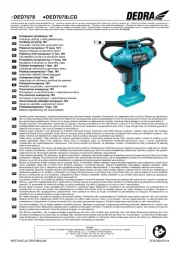
15 Juli 2025
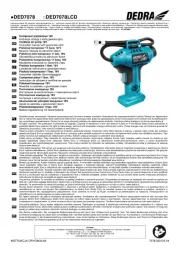
15 Juli 2025
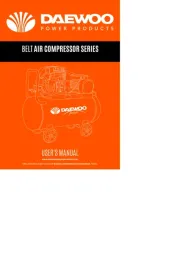
15 Juli 2025
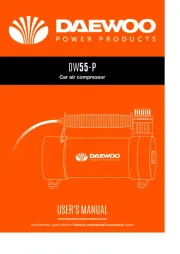
15 Juli 2025
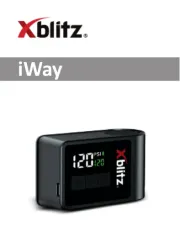
15 Juli 2025
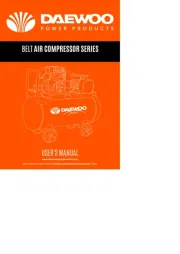
15 Juli 2025
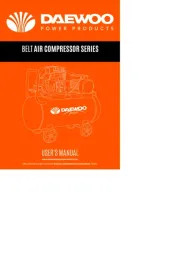
14 Juli 2025
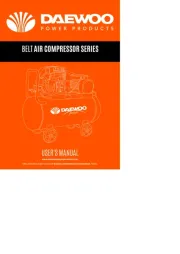
14 Juli 2025
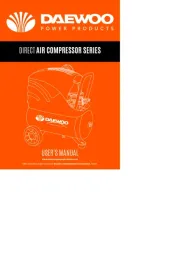
14 Juli 2025
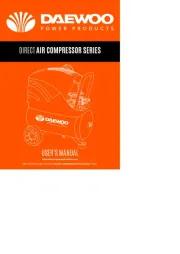
14 Juli 2025